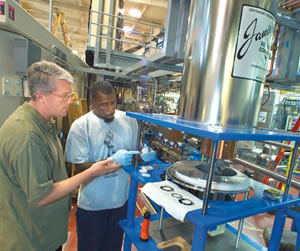
Operations Overview, page three
Knowledge Transfer: Good for Technology, Good for the Community
Berkeley Lab is a center of innovation and discovery, its work either contributing to the solutions to national problems or leading directly to benefits in the marketplace. It is also one of the laboratory’s top priorities to grow this rapid transfer of technologies so that industry can incorporate them into programs that improve the nation’s welfare.
The Lab has an impressive record in technology transfer; those innovations already in the marketplace include low-emissivity, coated windows; electronic ballasts for compact fluorescent lights; and advanced lipid protein tests for diagnosis of heart disease. More than 188 inventions have been transferred to industry in the last five years.
Also, more than 20 new companies that have spun off from Berkeley Lab research — including Symyx, Nanosys, Quantum Dot, Berkeley HeartLab, Nanomix, and Aeroseal — are responsible for nearly $2 billion in market capitalization and 800 new jobs in the Bay Area.
We have come a long way since our technology transfer office was established 15 years ago, but we can go still further. Through strengthening the technology transfer culture at the Lab, scientists will be transforming industries like biotechnology, information technology, and nanotechnology with exciting new processes and products. The dividends from such research accrue to the taxpayers, whose investments will be yielding tangible improvements in life and health, and for the scientists, who realize a fair return from their inventions to pursue more and better science.
Licensing revenue has grown by 20 percent a year over the last five years. And that total is likely to grow, thanks to tools like the Virtual Software Shop, a new central web site at the Lab with organized searchable access to open-source and other software. And, thanks also to an aggressive marketing strategy that matches the Lab community’s discoveries with private-sector interests and needs.
Educating Future Scientists and Engineers
No less important for the future of the nation is the role Berkeley Lab plays in the education of future scientists and engineers. Just as technology transfer enables improvements and advances in industry, so the Lab’s Center for Science and Engineering Education transfers critical knowledge, experience and real-world science to students from elementary grades through their undergraduate years. Teachers, too, are offered opportunities in front-line research that they may never have enjoyed in their career preparation.

Beamline scientist Michael Martin (left) works with student Christopher Taylor at the Advanced Light Source. Each year Berkeley Lab hosts hundreds of students, from 4th grade to graduate level, as part of its commitment to promoting and mentoring science.
Most agree that to encourage more students — in particular, women and underrepresented minorities — to pursue science as a career, one has to tap into
the “pipeline.” From grade school through college, promising young people need to be tracked and guided into research situations like those Berkeley Lab provides. And it is working. The Lab now gets 1,500 graduate and postdoctoral students each year to work in its programs, an increase of 56 percent over the past five years. In 2004, these students comprised 21 percent of the Lab’s staff.
Intervention can come up and down the pipeline — in K-12, where the Lab runs a program of tours, workshops, and summer work experiences; at the undergraduate college level, with jobs and internships; and with graduate students and post-docs. Once they are here, it’s up to the mentors at Berkeley Lab — over 100-strong at any one time — to teach and to share their excitement about the profession.
Berkeley Lab intends to expand its student tracking system and hold its divisions accountable for pipeline recruitment success through the Director’s Annual Work Force Review. A database developed by the Physical Biosci-ences Division will serve as a model for web-based tracking and mentoring.
One of the tangible illustrations of Berkeley Lab’s commitment to local schools came in 2005 in the form of an offer to help the cash-strapped Berkeley city schools in their students’ preparation for standardized state tests. With little money or time available for science instruction, the district welcomed volunteer Lab instructors as they visited all fifth graders in 11 schools and taught lessons geared toward the physical and earth sciences.
Information transfer isn’t just limited to those in school. Berkeley Lab maintains an active community relations program, including its open-membership “Friends of Science” organization that sponsors public scientific talks for the layman, both on and off-site. The “Friends” roster grew to over 400 in 2004, reflective of a continuing hunger for knowledge about science.